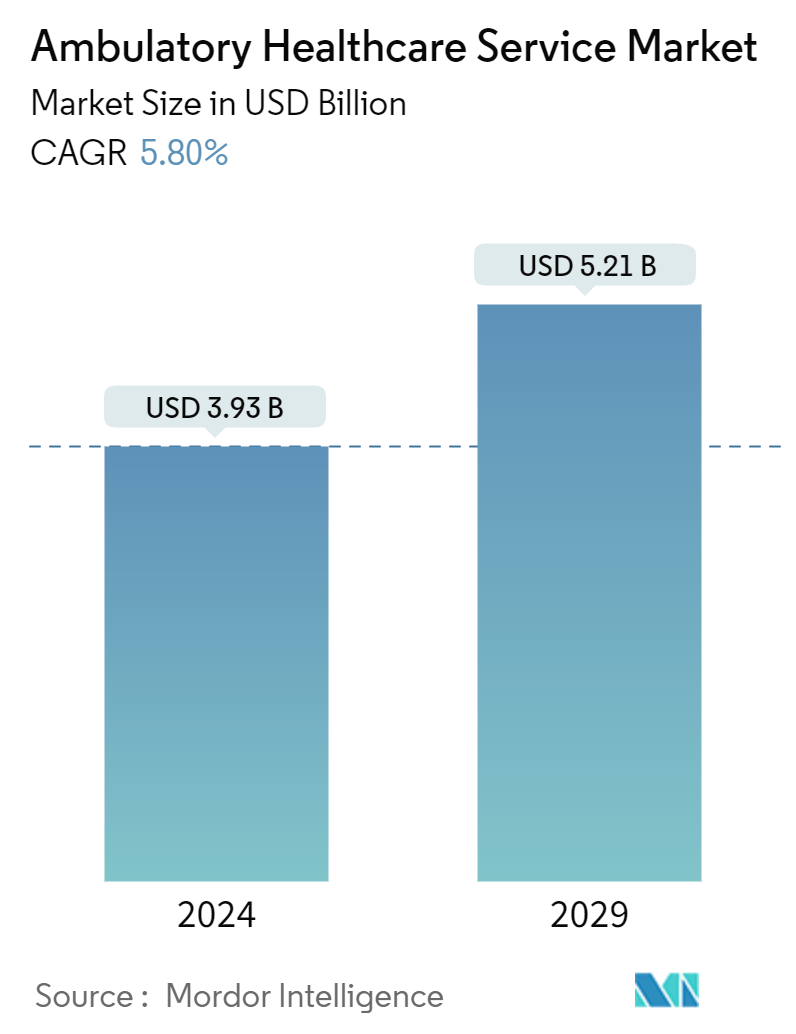Market Size of Ambulatory Healthcare Service Industry

| Study Period | 2019 - 2029 |
| Market Size (2024) | USD 3.93 Billion |
| Market Size (2029) | USD 5.21 Billion |
| CAGR (2024 - 2029) | 5.80 % |
| Fastest Growing Market | Asia Pacific |
| Largest Market | North America |
Major Players
*Disclaimer: Major Players sorted in no particular order |
Ambulatory Healthcare Service Market Analysis
The Ambulatory Healthcare Service Market size is estimated at USD 3.93 billion in 2024, and is expected to reach USD 5.21 billion by 2029, growing at a CAGR of 5.80% during the forecast period (2024-2029).
The major factors for the growth of the ambulatory healthcare service market are the increasing geriatric population and rising prevalence of chronic diseases, rising demand for minimally-invasive surgeries, and technological advancements.
The prevalence of chronic diseases is increasing across the world, due to the rapidly aging population and greater longevity of people with chronic conditions. Along with an increase in the number of patients with specific diseases, the prevalence of multi-morbidity, i.e., the presence of multiple diseases in the same individual, is rising. The sedentary lifestyles are boosting obesity rates, as well as the incidence of various diseases. According to the World Health Organization (WHO), chronic disease prevalence is expected to rise by 57%, in 2020. Emerging markets may be hit the hardest, as population growth is anticipated be most significant in developing countries. Increased demand for healthcare systems, due to chronic disease, has become a major concern. Similarly, chronic disease is expected to boost the demand for ambulatory healthcare services. According to the studies conducted by WHO, by 2020, chronic diseases are projected to account for almost three-quarters of all deaths worldwide. The studies also estimated that 71% of the deaths may be caused due to ischaemic heart disease (IHD), 75% due to stroke, and 70% due to diabetes, in the developing countries. Consequently, the increasing incidence of chronic diseases is expected to drive the growth of the ambulatory healthcare service market.
Ambulatory Healthcare Service Industry Segmentation
As per the scope of this report, ambulatory care or outpatient care is medical care that is provided on an outpatient basis, which includes diagnosis and the treatment of diseases. The market is segmented by type, application, and geography.
Ambulatory Healthcare Service Market Size Summary
The ambulatory healthcare service market is experiencing significant growth driven by several key factors, including the increasing geriatric population, the rising prevalence of chronic diseases, and the growing demand for minimally invasive surgeries. Technological advancements also play a crucial role in this expansion. The global rise in chronic diseases is largely attributed to an aging population and longer life expectancy among those with chronic conditions, leading to a higher incidence of multi-morbidity. Sedentary lifestyles are contributing to obesity and related health issues, further escalating the demand for ambulatory healthcare services. This trend is particularly pronounced in emerging markets, where population growth is expected to be most significant. The demand for healthcare systems to address these chronic conditions is a major concern, and as a result, ambulatory healthcare services are becoming increasingly essential.
North America holds a significant share of the ambulatory healthcare service market, with expectations of continued dominance over the forecast period. The market encompasses outpatient services such as physician and dentist offices, home healthcare, and medical laboratories, excluding inpatient care like hospitals and nursing facilities. The United States, in particular, benefits from a robust healthcare infrastructure and a high prevalence of chronic diseases, driving market growth. The market is characterized by fragmentation, with numerous players engaging in partnerships to enhance their market presence. Notable collaborations, such as the joint venture between HPI Holdings LLC, INTEGRIS, and United Surgical Partners International, highlight the competitive landscape. The rising prevalence of gastric and digestive diseases is also contributing to the demand for ambulatory services, as evidenced by the significant billing for gastroenterology services in ambulatory surgical centers.
Ambulatory Healthcare Service Market Size - Table of Contents
-
1. MARKET DYNAMICS
-
1.1 Market Overview
-
1.2 Market Drivers
-
1.2.1 Increasing Geriatric Population and Rising Prevalence of Chronic Diseases
-
1.2.2 Rising Demand for Minimally-invasive Surgeries
-
1.2.3 Technological Advancements
-
-
1.3 Market Restraints
-
1.3.1 Regulatory and Operational Uncertainties
-
-
1.4 Porter's Five Forces Analysis
-
1.4.1 Threat of New Entrants
-
1.4.2 Bargaining Power of Buyers/Consumers
-
1.4.3 Bargaining Power of Suppliers
-
1.4.4 Threat of Substitute Products
-
1.4.5 Intensity of Competitive Rivalry
-
-
-
2. MARKET SEGMENTATION
-
2.1 By Type
-
2.1.1 Primary Care Office
-
2.1.2 Surgical Specialty Office
-
2.1.3 Emergency Department
-
2.1.4 Medical Specialty Office
-
2.1.5 Other Types
-
-
2.2 By Application
-
2.2.1 Ophthalmology
-
2.2.2 Orthopedics
-
2.2.3 Gastroenterology
-
2.2.4 Pain Management
-
2.2.5 Other Applications
-
-
2.3 Geography
-
2.3.1 North America
-
2.3.1.1 United States
-
2.3.1.2 Canada
-
2.3.1.3 Mexico
-
-
2.3.2 Europe
-
2.3.2.1 Germany
-
2.3.2.2 United Kingdom
-
2.3.2.3 France
-
2.3.2.4 Italy
-
2.3.2.5 Spain
-
2.3.2.6 Rest of Europe
-
-
2.3.3 Asia-Pacific
-
2.3.3.1 China
-
2.3.3.2 Japan
-
2.3.3.3 India
-
2.3.3.4 Australia
-
2.3.3.5 South Korea
-
2.3.3.6 Rest of Asia-Pacific
-
-
2.3.4 Middle East & Africa
-
2.3.4.1 GCC
-
2.3.4.2 South Africa
-
2.3.4.3 Rest of Middle East & Africa
-
-
2.3.5 South America
-
2.3.5.1 Brazil
-
2.3.5.2 Argentina
-
2.3.5.3 Rest of South America
-
-
-
Ambulatory Healthcare Service Market Size FAQs
How big is the Ambulatory Healthcare Service Market?
The Ambulatory Healthcare Service Market size is expected to reach USD 3.93 billion in 2024 and grow at a CAGR of 5.80% to reach USD 5.21 billion by 2029.
What is the current Ambulatory Healthcare Service Market size?
In 2024, the Ambulatory Healthcare Service Market size is expected to reach USD 3.93 billion.

